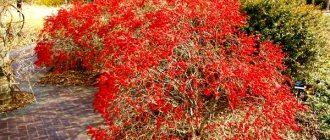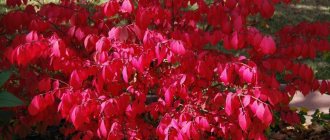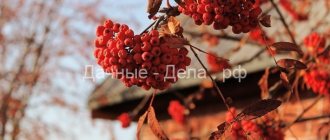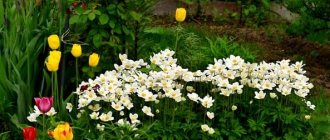There are about 400 species of trees and shrubs in the genus Holly, the Holly family, growing from the tropics to temperate latitudes. The diversity of holly species sometimes combines plants with radically opposite characteristics.
They can be either deciduous or evergreen, creeping shrubs and multi-meter giants. Both prickly serrated leaves and completely smooth entire-edged leaves can coexist in one leaf rosette. All hollies are dioecious species. Small, light-colored flowers are located in the leaf axils. The fruits are berry-shaped, drupe-type.
Holly is classified as a moisture-loving and shade-tolerant plant. For propagation, seeds that have undergone 18 months of stratification are used. They do not refuse the vegetative method of propagation, although they do not like transplants and get very sick when taking root in a new place.
The plant is valued for its decorative value, for the fact that it is able to keep its shape for quite a long time after being cut. Since ancient times, its branches have been treated with respect, believing that they resist evil spirits if strengthened above the entrance. The branches of the plant are still used in Christmas wreaths and garlands. They are often found on the covers of New Year's cards in the countries of the Old World.
Growing conditions and care for holly
All types of holly tolerate partial shade and shade well without experiencing discomfort. However, they also develop excellently in the sun. By the way, young shoots should be protected from sunlight in the spring. They prefer nutritious soils with a high humus content, well drained. If you have light loam, add humus and sand to it to improve the mechanical and nutritional properties of the soil.
It is difficult to transplant, but if it is absolutely necessary to replant the plant, do it in early spring, then the operation will take place with minimal damage.
Holly holly in the Moscow region
In winter, evergreen holly becomes a luxurious garden decoration
Unfortunately, it is possible to grow European holly in the garden (and only some winter-hardy hybrids - for example, Ilex x meservae) only in areas with a mild climate, where frosts do not fall below -20°C, and then only for a short time. Among the well-known varieties that can withstand the cold winters of the Moscow region are the following: “China Girl”, “Blue Maid”, “China Boy”, “Blue Baron”, “Blue Princess”.
Holly care requirements:
- Regular watering is required during dry periods.
- Fertilizing can be done in the spring, during the period of active growth of green mass. Choose complex mineral fertilizers, possibly with a predominance of nitrogen. Responds well to organic fertilizers.
- To form the crown, pruning is used. It is also useful to remove damaged and dried branches.
Why holly doesn't have berries - reasons
Why does holly have no berries? What should I do?
Holly is a dioecious plant. This means that there are “male” and “female” plants, and only bushes with pistillate, female flowers produce fruit. To see beautiful berries, you need to plant a female and a male plant next to each other.
Photos of female and male holly flowers. Above is a branch from a male plant, below is from a female plant.
- Flowers and berries only develop on two-year-old branches, so you need to be careful when pruning.
- If you cut the branches too short, the plant may not bloom.
- The danger of cutting out flower buds increases with summer and autumn pruning.
- It's best to prune holly in the spring so it can set flower buds for next year.
Holly can drop flowers and ovaries if it lacks moisture. Therefore, you need to ensure that the soil does not dry out. In addition, severe frost in winter or spring frosts can also damage fruit branches, which is why the berry harvest may not be seen.
Diseases and pests
Among the pests, aphids are known to attack young shoots. Evergreen species are affected by large insects and leaf rollers. Control means: treatment with appropriate insecticides. Sometimes root rot develops on holly, caused by late blight, which is widespread everywhere. Prevention - arrangement of drainage when planting a plant, preventing stagnation of water during precipitation.
Holly in New Year's floristry, and not only in New Year's
Holly leaves and berries are actively used in floristry. When working with the leaves of this plant, you must be careful, as they have pointed ends that can cause injury. One side of the hard sheet is glossy, the other is matte; contrasting compositions are often built on this difference. Berries can be used in decorative compositions. Holly shoots are very persistent and good for Christmas and New Year's arrangements.
Holly branches can be kept in a vase for 2 weeks. Before planting, trim the holly branches with pruning shears and pour water at room temperature.
Holly in a floral composition
Propagation of holly by cuttings
Holly propagation by cuttings
It is difficult to propagate the plant by seeds: since the flowers are dioecious, artificial pollination is required. Seeds need to be planted after a long period of stratification. In nature, this period takes 1.5 years. gardeners place the seeds in the refrigerator in the fall and plant them in the spring. You can wait even 2-3 years for germination.
Therefore, cuttings or layering are used to propagate holly.
- Annual non-lignified cuttings are cut 10-12 cm long.
- All leaves are removed from the lower third along the length.
- Next, the cuttings are kept for a day in a root solution and germinated in plain water until roots appear.
Holly cuttings take root simply in water
- You can “plant” the cuttings in a shady place in the garden or plant them in cups for rooting on a windowsill.
- By providing watering and good drainage, you will get good seedlings after 2-3 months.
- Cuttings germinated in water are first planted in pots for growing.
- New plants can only be planted in open ground next spring.
Before the onset of winter, the bushes will have time to grow their root system and the branches will ripen in order to survive the cold period. But to be sure of a successful winter, in the fall the bushes are covered with earth and covered with spruce branches.
Medicinal properties
The plant not only has a beautiful appearance, but also has medicinal properties. Holly leaves are used to treat heart diseases, as well as colds and kidney diseases. It is often recommended to brew holly to combat rheumatism, dropsy and arthritis.
To prepare the infusion, you will need to spend a minimum amount of time. Follow the steps:
- Pour a couple of tablespoons of plant leaves into a glass of vodka.
- Transfer the liquid to a dark place and leave for a week.
- Strain, dilute with water and take 20 drops orally twice or thrice a day on an empty stomach.
Holly holly is a beautiful plant that adorns many garden plots. It is used both to create a unique design and for medicinal purposes. Since it requires virtually no care, the plant continues to win more and more hearts of gardeners.
Holly propagation by layering
Reproduction of holly by layering photo
If you already have holly growing, you can propagate it by bending the branches and covering them with soil.
- To prevent the branches from springing and jumping out, it is better to pin them to the ground with metal brackets, removing the leaves in the place where you will sprinkle the soil.
- After a while, roots will appear here, and then new branches.
- The next season, in the spring, the seedling is carefully separated from the mother plant and planted in a designated place.
Synonyms[edit | edit code]
According to The Plant List[4]
- Ilex crenata
var.
aureovariegata
Goldring - Ilex crenata
f.
bullata
Rehder - Ilex crenata
f.
helleri
(Craig) Rehder - Ilex crenata
var.
helleri
(Craig) L.H. Bailey - Ilex crenata
var.
latifolia
Goldring - Ilex crenata
f.
latifolia
(Goldring) Rehder - Ilex crenata
var.
longifolia
Goldring - Ilex crenata
f.
longifolia
(Goldring) Rehder - Ilex crenata
f.
longipedunculata
SY Hu - Ilex crenata
var.
luteovariegata
Regel - Ilex crenata
f.
luteovariegata
(Regel) Rehder - Ilex crenata
var.
mariesii
Bean ex Dallim. - Ilex crenata
f.
microphylla
Rehder - Ilex crenata
var.
multicrenata
CJ Tseng - Ilex crenata
f.
multicrenata
(C.J. Tseng) S.K. Chen - Ilex crenata
var.
nummularia
Yatabe - Ilex crenata
f.
nummularia
(Yatabe) H. Hara - Ilex crenata
f.
variegata
G. Nicholson - Ilex crenata
var.
variegata
(G. Nicholson) Dallim. - Ilex euryifolia
K. Mori & Yamam. - Ilex helleri
Craig
How to Plant Holly
- The seedling in the pot is first watered to soften the earthen lump so that it can be easily pulled out.
- The hole is prepared in advance, approximately three times the size of the pot in depth and diameter. At least 3-4 cm of drainage is laid at the bottom of the hole: this can be broken brick, small crushed stone or any other material that facilitates the drainage of water from the top layer of soil.
- Sprinkle humus on top (about half a bucket per hole, mixed in half with soil.
- Then the seedling is placed vertically and sprinkled with nutritious soil, trying to only slightly deepen the root collar. This will prevent the roots from being exposed after the soil subsides. The plant tolerates slight deepening calmly. Water abundantly, but without stagnation of water.
Biological description[edit | edit code]
The serration of the leaves of the plant is visible
An evergreen shrub or small tree 3-5 meters high (occasionally up to 10 meters), with a trunk diameter of up to 20 cm.
The leaves are shiny, dark green, 10-30 mm long and 10-17 mm wide, with a serrated, sometimes spiny edge.
The flowers are dioecious, white, with four petals.
The fruit is a black drupe, 5 mm in diameter, with four seeds.
Types and varieties of holly with descriptions and photos
Rugosa holly Ilex rugos
Wrinkled holly - Ilex rugosa Fr. Schmidt
The entire Far East from Primorye to Sakhalin was “occupied” by wrinkled holly. Preference is given to fir-spruce and cedar-spruce forests. Belongs to evergreen creeping shrubs. Its height does not exceed 0.5 meters. Does not tolerate excessively cold winters, partially frostbiting. It is not suitable for landscaping park areas and summer cottages.
In the spurs of the Sikhote-Alin in the shade of Ayan spruce trees, wrinkled holly is found both individually and in groups. It is very comfortable here, since a thick blanket of snow saves the plant from destructive frosts in winter, and in the summer, due to the high humidity, very favorable conditions are created for its growth.
Holly is common to the inhabitants of Sakhalin, as well as the southern Kuril Islands. This plant is the oldest representative of the flora throughout the Far East. Even in the Tertiary period, wrinkled holly grew in the region along with beech and magnolia. And only a miracle helped this trio survive on the islands of the southern Kuril Islands. In Primorye, magnolia and beech have become extinct.
Whorled holly Ilex verticillata
Deciduous whorled holly in the photo variety Ilex verticillata Maryland Beauty
It is a close relative of the holly and is common in North America. It is a deciduous form. It grows in height from one to three meters, the crown is dense and densely covered with fleshy leaves of rich color. The flowers are inconspicuous and small. Bright dark red berries can only be seen on pistillate plants, but for pollination to occur, staminate specimens must also be planted.
Among the hollies there are many deciduous species. The whorled holly, which grows in North America, is famous for its greatest ornamental value. It grows along river banks, in swamps and loves moisture. Prefers humus soil in the shade of the southern side of the garden plot. Sunny places are simply contraindicated for him. Requires special protection from winter sun rays. Does not tolerate drought. Its branches have an olive-purple tint, and large elliptical leaves change color from dark green to yellow-orange with the onset of autumn.
Holly Ilex Aquifolium
Holly variety Silver Queen Ilex Aquifolium Silver Queen Silver queen photo
The wild species of the plant is common in southern Europe, the vast expanses of North America and Asia Minor. It can be presented as a dwarf evergreen. But a tree that reaches a height of 15 meters is also called holly. Its dense pyramidal or oval crown is formed by short spreading branches.
The oblong-ovate, short-petiolate leaf of the plant is characterized by the presence of a wavy edge, triangular teeth and large spines. The snow-white flowers, located on short stalks, are very fragrant. Bright red spherical fruits, the diameter of which reaches 1 cm, can be stored throughout the winter on their stalks.
And although holly is considered a frost-resistant crop that can withstand temperatures of -22°C, this is not enough for central Russia, and the plant must be cultivated in a winter garden. He loves shady places, maybe that's why he doesn't grow fast. Has a lifespan of up to 100 years. It can be molded into a spherical or pyramidal shape. In general, different forms of holly are characterized by a discrepancy in the shape of the leaf and crown, and in the color scheme of the fruit. Holly holly can often be found in beech, fir and spruce forests of the North Caucasus.
This type of plant has slight differences from its European brother. Therefore, botanists united them under the names “Colchis holly”, the small leaves of which are pierced by strongly incised veins, and “Narrow-fruited holly”, the foliage of which is large and the fruit has a narrow stone. Colchis holly originates from the regions of Asia Minor and Transcaucasia. In these places it is a small tree, up to 2.5 m in height, with springy drooping branches or a shrub that spreads along the ground. In central Russia, shrubs up to 0.5 meters tall grow. Its dark green, leathery leaves are spiny and serrated. With the onset of autumn frosts, it freezes over, but, thanks to its ability to recover, it grows back.
Crenate holly Ilex crenata
Crenate holly Ilex crenata `Convexa` photo
Its homeland is considered to be Sakhalin Island and the Kuril Islands. Crenate holly is a tall tree, up to 7 meters tall. Rarely found as a bush. This type is very decorative. Its dense greenery, like boxwood, is pruned. The Japanese prefer the dwarf type of crenate holly and love to trim these bushes. In the Crimean-Caucasian region, the plant grows very slowly and bears almost no fruit.
Broadleaf holly Ilex leucoclada
Broadleaf holly Ilex leucoclada
It is found in China, has wide leaf blades, and is characterized by poor flowering and fruit formation.
Paraguayan holly Ilex paraguariensis
Paraguayan holly Ilex paraguariensis photo
The name speaks for itself; this plant comes from Paraguay, a country in central Africa with a very hot climate. Distributed in Uruguay, Argentina and Brazil. Tea made from Paraguayan holly leaves is called mate and has healing properties. The drink has a tonic effect and is brewed from dried leaves.
Colchis holly Ilex colchica
Colchis holly Ilex colchica photo
The shrub grows up to half a meter high and tolerates the conditions of central Russia well. Dense leathery leaves with spines along the edge densely cover the crown. The rich dark green color of the leaves is luxuriously emphasized by the waxy shine of the surface.
Hybrid holly
In the Moscow region, low-growing crenate holly and its hybrid varieties are grown. The hybrid obtained by crossing the Korean common holly with wrinkled holly has especially taken root. Its name is meserva. It is frost-resistant. The Blue Maid variety differs from the others in that flowers of different sexes are located on the same plant, although its green leaves do not have shine and are not as showy as, for example, Blue Angel. Most varieties have red or yellow fruits. They keep very well throughout the winter. Western Europeans use branches of the plant (always with brightly colored fruits) to decorate their rooms for Christmas.
Holly Meserva Blue Maid photo Planting and care
Large orange fruits look very attractive against the background of white snow and green coniferous trees. Sometimes flower shops offer plant branches for floral arrangements.
Application
Holly branches are a decoration used in many European countries. At Christmas, rooms are decorated with their shoots.
The leaves and fruits contain useful substances and are used in folk medicine and cooking.
Landscape design
Hollies are planted in gardens and greenhouses in groups or individually, used as hedges, to create topiaries. Hybrid variegated varieties look especially impressive. A dense decorative crown, easy to shape, slow growth, and relative unpretentiousness make these plants almost universal.
Tea
Leaves, young shoots and fruits of common, Paraguayan, Chinese and broadleaf holly species contain biologically active substances:
- theobromine, theophylline, caffeine and other alkaloids;
- glycosides;
- organic acids;
- bitterness;
- saponins;
- tannins;
- vitamins.
Kuding bitter tea is prepared from the young leaves of the Chinese holly. With its help, they strengthen the body, fight excess weight, high blood pressure, metabolic disorders, poor digestion, and nervous disorders.
Paraguayan holly is a raw material for making mate. This drink stimulates the cardiovascular system, brain function, improves mood, gives vigor, promotes detoxification and reduces fatigue, prevents apathy and depression.
The leaves and flowers of broadleaf holly are used in folk medicine to prepare diuretics, anti-inflammatory, analgesic, hemostatic and bactericidal agents.
Wood
The woody mass of holly is light brown, olive or yellowish in color with a contrasting natural pattern in appearance reminiscent of boxwood. Density is about 570–700 kg/m3. Biostability and resistance to moisture are below average. The fibers are located in different directions, making the wood difficult to process. However, the material lends itself well to sanding, gluing and painting. Due to its strength and decorative appearance, it is used for the manufacture of small parts, wooden decorations, souvenirs, and design elements.
Requirements for planting site and soil
Holly holly is not picky about the level of illumination, but does not tolerate exposure to direct sunlight, especially during the hot period. Therefore, it is recommended to plant bushes in partial shade. The level of soil moisture affects the development of holly: it likes moist, but not waterlogged soil.
Holly-leaved shrubs do not develop well in heavy soil types and are susceptible to damage at sub-zero temperatures. Based on the pH level, select an area with acidic or slightly acidic soil.
We prepare holes for planting in the fall. To do this, we go deeper into the depth of the shovel by 3 bayonets. We fill the bottom with a layer of broken bricks or sand for drainage. Mix the same amount of manure, peat and fertile soil layer, pour it into the hole. The minimum distance between holes is 2 m. The volume of the hole should exceed the size of the root system by 3 times.
Landing
In the spring, when the warmth has settled, we begin preparations for planting. If the holes have not been made since the fall, dig them and fill them with the nutrient mixture according to the previous scheme. We place a one-year-old seedling in the hole, fill a bucket of water and carefully, so as not to damage the roots, fill the hole with soil. It is advisable to place a peg for a garter near each bush.











